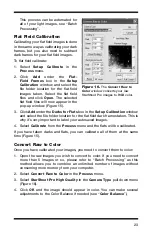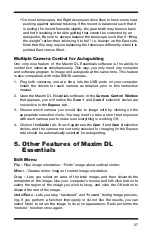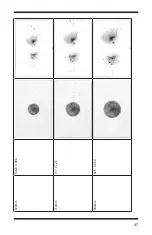
35
autoguider Calibration
In order to properly control the mount, you must calibrate the system. The
exact orientation of the StarShoot Pro, the focal length of the guide telescope
optics, and the speed of the motor drive all affect the calibration. To perform
autoguider calibration:
1. Switch to the
Guide
tab.
2. Set the
X
and
Y Aggr
(aggressiveness) to 8 to start with. Set the
Exposure
to 1.0 second. Under
Guide Star
, make sure the
Watch
box is checked.
Note: The
X
and
Y Aggr
(aggressiveness) controls on the Guide tab allows
you to adjust how vigorously star motions are tracked out in each axis. An
aggressiveness setting of 10 means that the StarShoot Pro attempts to track
out 100% of the motion, whereas a setting of 1 means that the StarShoot Pro
only tracks out 10% of the motion. Usually a setting of around 8 or 9 provides
the best tracking, since it reduces overshoot and helps ignore random motions
due to atmospheric seeing and wind loads. You should experiment to deter-
mine the best setting for your particular telescope.
3. Click the
Settings
button.
4. Maxim DL Essentials needs to know how fast the telescope moves in right
ascension (R.A.) and declination (Dec.) when the autoguider commands
are issued. To do this, the software will
Calibrate
the mount by moving it
back and forth on each axis. The
Calibration
Time determines how long it
activates the motors each time. The usual value is 5-10 seconds; start out
with a value of 5.
5. Make sure all of the
Guider Enables
boxes are checked.
6. For
Autoguider Output
, set
Control Via
and
COM Port
as required for
your telescope equipment. See “Computer to Mount Connection” if you
have not already done this.
7. Click
Apply
. You can leave this dialog box open, or
Close
it if you wish.
8. Make sure that the telescope mount is set to move at 1X sidereal or slower.
For some mounts, you must set the guide rate manually. The maximum
usable rate is 1X sidereal. If your mount does not drift quickly, then 0.1X is
recommended; otherwise use a value between 1X and 0.1X.
9. On the
Guide
tab, set to
Expose
, and click the
Start
button. A single
image will be taken. Ensure that a well-focused bright star (near the actual
object to be imaged) appears in the image. If not, adjust the guide scope
and try again. Make sure the star is roughly centered.
Note: The algorithm can be confused if another star appears in the frame; to
minimize this risk, calibrate on an isolated bright star.
10. Now, set to
Calibrate
, and click the
Start
button. A series of five expo-
sures will be taken; each time the telescope will be moved slightly. If the






























